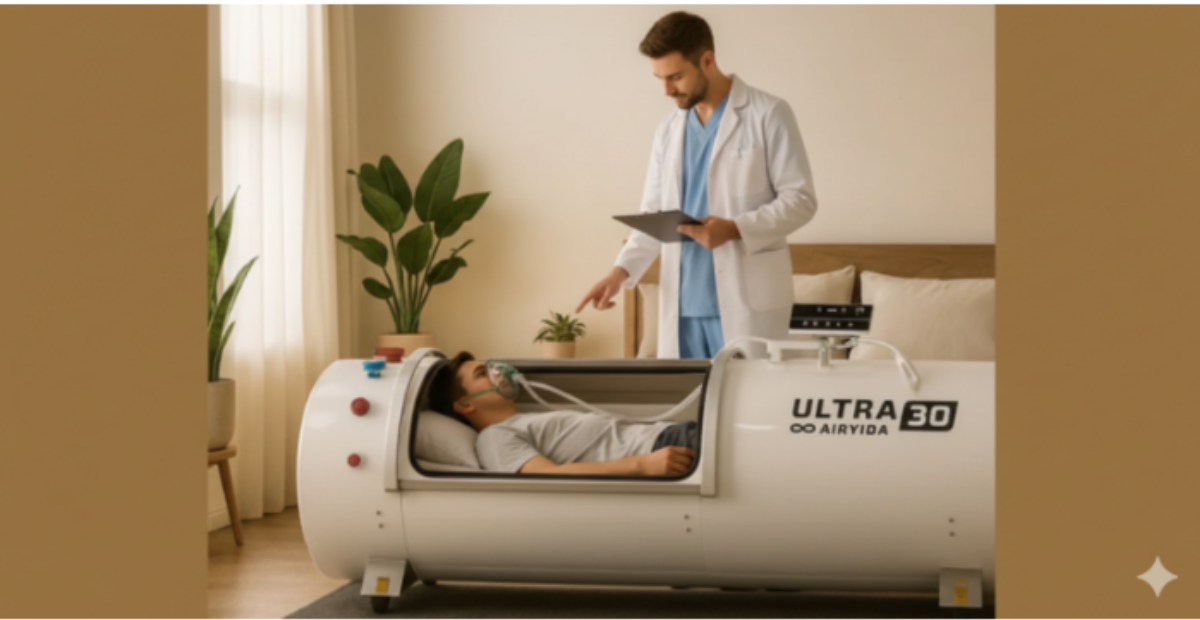A hospital hyperbaric chamber is a medical device that delivers pure oxygen in a controlled environment to help the body heal faster. It’s used to treat wounds, infections, and other oxygen-related conditions by increasing oxygen levels in the blood.
If you’ve ever wondered how hospitals utilize hyperbaric chambers and what makes them so effective, this guide explains their purpose, the treatment process, and the health benefits. It also shares insights into patient experiences, illustrating how HBOT can support recovery, wellness, and overall quality of life in medical settings.
Understanding What a Hospital Hyperbaric Chamber Does
A hospital hyperbaric chamber is a sealed room or tube where patients breathe 100% oxygen under higher-than-normal atmospheric pressure. This pressure allows oxygen to dissolve more effectively into blood plasma, enhancing tissue repair and reducing inflammation.
Why Hospitals Use Hyperbaric Oxygen Therapy (HBOT)
Hospitals use HBOT to treat various medical conditions, including:
-
Non-healing diabetic wounds
-
Carbon monoxide poisoning
-
Radiation tissue damage
-
Severe infections
-
Air or gas embolisms
Hyperbaric oxygen therapy is widely endorsed by medical organizations for its capacity to enhance oxygen delivery throughout the body, reduce inflammation and swelling, and stimulate angiogenesis. These effects collectively support tissue repair, accelerate healing, and improve overall recovery outcomes for patients with diverse medical and wellness needs.
Fun fact: Breathing oxygen in a pressurized environment can deliver 10–15 times more oxygen to tissues than normal air!
How a Hospital Hyperbaric Chamber Works Step-by-Step

During a hyperbaric oxygen therapy session, your body is exposed to pure oxygen at elevated pressures. This process increases oxygen absorption in the blood, promotes cellular repair, reduces inflammation, and supports tissue healing, giving the body an optimal environment for recovery and regeneration.
|
Step |
Description |
|
1. Preparation |
The patient lies down in the chamber, removing any flammable items. A technician ensures comfort and safety. |
|
2. Pressurization |
The chamber pressure gradually increases, simulating the feeling of descending underwater. |
|
3. Oxygen Therapy |
Once at target pressure, the patient breathes pure oxygen for 60–120 minutes. |
|
4. Decompression |
Pressure is slowly released to return to normal levels safely. |
The entire process is painless, though some patients feel mild ear popping (like during airplane takeoff).
Hospital vs. Home Hyperbaric Chambers: What’s the Difference?
While both hospital and home hyperbaric chambers deliver oxygen therapy, hospital chambers are built for medical-grade treatments under professional supervision. They offer higher pressure levels, precise monitoring, and advanced safety features, making them suitable for severe conditions, post-surgical recovery, or complex medical cases requiring controlled, clinical environments.
|
Type |
Pressure Range |
Supervision |
Common Uses |
|
Hospital Hyperbaric Chamber |
2.0–3.0 ATA |
Certified medical staff |
Chronic wounds, decompression sickness, infections |
|
Home or Mild Hyperbaric Chamber |
1.3–1.5 ATA |
Self-administered or monitored remotely |
Wellness, recovery, anti-aging |
Hospital-grade models can reach deeper tissue oxygenation levels, making them essential for serious conditions. For general wellness or recovery, mild chambers are more common and accessible.
If you’re curious about at-home options, explore the affordable hyperbaric chamber collection for safe, user-friendly alternatives designed for personal use.
What Patients Feel During a Hospital Hyperbaric Session
Most patients describe their sessions as relaxing and even meditative. The chamber is transparent, allowing communication with medical staff. You can listen to music, watch TV, or simply rest.
Some mild sensations, like ear fullness, occur as pressure changes, but technicians help with equalization. Once the pressure stabilizes, breathing feels normal just with purer, more concentrated oxygen.
Benefits of a Hospital Hyperbaric Chamber
The primary goal of hyperbaric oxygen therapy is to increase oxygen delivery to the body’s cells, promoting faster healing. Enhanced oxygen flow supports tissue repair, reduces inflammation, aids in infection control, and boosts overall cellular function, helping the body recover more efficiently from injuries, chronic conditions, or post-surgical stress.
Key Benefits Include:
-
Faster wound healing after surgery or injury
-
Reduced swelling and inflammation
-
Improved circulation in damaged tissues
-
Enhanced immune response
-
Detoxification from carbon monoxide or gas poisoning
According to many hospital case studies, HBOT can reduce recovery time by up to 40% in certain wound-care patients.
To learn more about different therapy options, you can read our comparison of HOCATT vs. hyperbaric chamber and see which suits your needs best.
Safety and Medical Supervision in Hospitals
Every hospital hyperbaric chamber session is carefully monitored by certified technicians and physicians to ensure safety. Strict protocols are followed, including pressure regulation, continuous patient observation, emergency readiness, and adherence to medical guidelines, minimizing risks and ensuring that each treatment delivers maximum therapeutic benefits effectively and reliably.
-
Real-time oxygen monitoring
-
Temperature and humidity control
-
Two-way communication systems
-
Emergency decompression features
Throughout each session, trained medical staff monitor your vital signs, comfort, and response to treatment closely, ensuring that every aspect of the therapy is conducted safely, effectively, and with immediate attention to any issues, maximizing the benefits of hospital-based hyperbaric oxygen therapy.
Who Can Benefit from Hospital Hyperbaric Therapy?

HBOT serves a wide range of patients, from those experiencing acute medical emergencies like carbon monoxide poisoning to individuals undergoing long-term recovery for chronic conditions. Hospitals utilize hyperbaric therapy to support healing, reduce inflammation, and enhance oxygen delivery across diverse clinical scenarios safely and effectively.
Common Patient Categories:
-
Diabetic foot ulcer patients
-
Post-surgery recovery cases
-
Cancer survivors with radiation tissue injury
-
Burn victims
-
Divers recovering from decompression sickness.
If you’re exploring personal wellness benefits, our buy hyperbaric chamber collection offers a range of models inspired by hospital-grade design.
Practical Tips Before Trying HBOT in a Hospital
Before starting HBOT in a hospital setting, it’s important to understand preparation steps, safety measures, and session expectations. Proper planning ensures maximum benefits, minimizes risks, and helps you feel comfortable and confident during therapy, setting the stage for a safe, effective, and well-monitored oxygen treatment experience.
-
Eat a light meal before your session
-
Avoid caffeine or smoking
-
Remove jewelry, makeup, and synthetic fabrics
-
Communicate any ear or sinus issues with your technician
Pro Tip: Consider bringing a favorite playlist or calming audio during your session. Listening to relaxing music, podcasts, or guided meditations can reduce stress, enhance focus, and make the hyperbaric therapy experience more enjoyable, helping you stay comfortable and mentally engaged throughout the treatment.
Summary: Why a Hospital Hyperbaric Chamber Matters
A hospital hyperbaric chamber provides a safe, proven method for oxygen-based healing. By increasing oxygen delivery deep into tissues, it accelerates recovery, supports cell regeneration, and offers comfort to patients battling complex conditions.
While hospitals use advanced models for medical-grade care, at-home hyperbaric options now make similar benefits more accessible. With the right guidance and quality equipment, anyone can experience the restorative power of oxygen therapy.
If you want to understand how professionals are trained to operate these systems safely, explore hyperbaric chamber training essentials for more insights.
Frequently Asked Questions About Hospital Hyperbaric Chambers
Why are doctors against hyperbaric oxygen therapy?
Some doctors are cautious about hyperbaric oxygen therapy because not all conditions benefit equally. However, many hospitals recognize that a hospital hyperbaric chamber can be highly effective for specific, FDA-approved uses such as wound care and carbon monoxide poisoning. The key is proper supervision and patient evaluation before starting therapy.
Do they still use oxygen tents in hospitals?
Oxygen tents are largely outdated, replaced by modern delivery methods like nasal cannulas and hyperbaric chambers. The hospital hyperbaric chamber offers far greater oxygen concentration and control, allowing precise treatment. This upgrade in technology makes therapy safer and more effective, reducing infection risk compared to old oxygen tents.
How long does a patient stay in a hyperbaric chamber?
Each session typically lasts 60 to 120 minutes. Patients undergoing treatment in a hospital hyperbaric chamber may have several sessions per week, depending on their condition. Chronic cases, like diabetic ulcers, may require 20–40 sessions. The schedule is carefully designed by medical professionals to ensure optimal healing outcomes.
What are the risks of hyperbaric therapy?
While generally safe, some people may experience mild discomfort like ear pressure or temporary fatigue. Serious side effects are rare when therapy is conducted in a hospital hyperbaric chamber under expert care. Hospitals minimize risks by carefully controlling oxygen levels, pressure changes, and session durations to ensure every treatment remains within safe limits.




